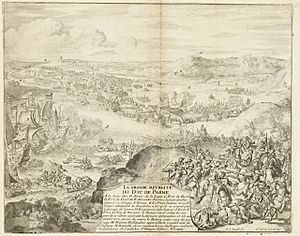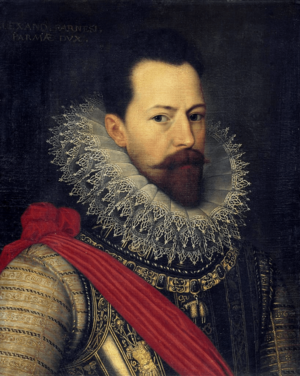Siege of Caudebec facts for kids
Quick facts for kids Siege of Caudebec |
|||||||
|---|---|---|---|---|---|---|---|
| Part of the French Wars of Religion and the Anglo–Spanish War | |||||||
 Retreat of the army of the Duke of Parma into Flanders in May of 1592 Rijksmuseum |
|||||||
|
|||||||
| Belligerents | |||||||
Supported by: |
|||||||
| Commanders and leaders | |||||||
| Strength | |||||||
| 25,000 | 15,000 | ||||||
| Casualties and losses | |||||||
| Unknown | Heavy | ||||||
The Siege of Caudebec was a major military event that happened from April 24 to May 21, 1592. It was part of two bigger conflicts: the French Wars of Religion and the Anglo-Spanish War (1585–1604). During this time, the Spanish army and their allies, the French Catholic League, captured the town of Caudebec.
However, they soon found themselves trapped. The Royalist army, led by Henry of Navarre, surrounded them. Henry's army included French, English, and Dutch soldiers. Seeing no way out, the Duke of Parma, who led the Spanish forces, made a daring escape. He moved his 15,000 soldiers across the Seine river in just one night to get away.
Contents
Why the Siege Happened: The Background
Before the siege, the Duke of Parma's Catholic forces had helped the city of Rouen in April 1592. They cleverly avoided a direct fight with Henry's Protestant army. After entering Rouen, Parma marched his troops west towards Caudebec. This town on the Seine river was important because it blocked the way to the port of Le Havre.
At the same time, Henry's army was getting weaker. Many soldiers were sick, and some had left to join the Catholic League. Henry needed to stop and get more supplies for his troops. After getting what they needed, Henry's army grew stronger. The Duke of Montpensier joined him after securing Western Normandy.
Henry's army now had about 25,000 soldiers. This included 7,000 English troops and 3,000 Dutch troops. Most of their cavalry (soldiers on horseback) were French. Dutch warships also helped Henry by controlling the sea route to the Seine river. Parma's forces easily took Caudebec and then worked on making the town's defenses stronger.
The Siege of Caudebec Begins
The Duke of Parma wanted to keep the Seine river open. This would allow his troops to get supplies and move easily. But Henry saw this as a mistake for Parma. It meant the Spanish forces were now stuck in a small area between the river and the sea. Dutch ships were already in the river, making it harder for Parma.
Henry's forces gained control of the Seine both above and below Caudebec. They held Pont de l’Arche, which was the last bridge over the river between Rouen and Caudebec. As Henry's army got closer to Caudebec, the Catholic forces got ready for a siege.
Within a few days, Henry's large army easily broke through the outer defenses of the Catholic League. This left the town open to attack. During this time, Parma was wounded in the arm while visiting a gun position. The Duke of Mayenne took over command while Parma recovered. Henry's army then took control of every passage around the town and made them stronger.
There were many fierce small battles every day. Eventually, Henry's plan worked. The Catholic League's army was completely trapped between the river and the sea. On the third day, Henry's forces cut off and captured a group of enemy cavalry nearby. They took a lot of supplies, food, and money. This made things very difficult for Parma's soldiers, who were already running low on food.
Parma was in a very bad situation. The only way to escape was to cross the river. Even though his most experienced officers thought it was impossible, Parma decided to try.
Parma's Daring Escape Across the River
Parma ordered a small fort to be built on his side of the river. On the opposite bank, he built another one. He placed cannons there with 800 Flemish soldiers in one fort and 800 Walloon soldiers in the other. He gathered all the flatboats, ferries, and rafts he could find from Rouen.
Under the cover of his forts, Parma began moving his soldiers. During the night of May 22, he transported all his Flemish infantry and his Spanish, French, and Italian cavalry to the other side of the Seine. At the same time, cannons were set up along the riverbanks. These cannons fired to keep the Dutch fleet away.
The next morning, he sent all his artillery and Flemish cavalry to Rouen. He even used parts of a destroyed bridge to make the distance shorter. This amazing effort allowed him to move his entire army, along with all their supplies, across the river. A small group of soldiers stayed behind until the very last moment. They kept fighting and showing themselves to trick Henry's army. The young Prince of Parma, Ranuccio I Farnese, Duke of Parma, led this group. The escape was a great success.
Henry did not find out about Parma's escape until it was already done. When the King reached the Seine river, he saw the last of Parma's army crossing. This included the soldiers from the fort on the right bank. Henry was shocked. He quickly ordered his cannons to fire at the escaping soldiers. However, the attack did not do much damage. The Catholic Spanish force then marched south. Henry tried to chase them with his cavalry, but it was too late. His infantry could not catch up in time.
What Happened Next
Parma's escape was complete, but he had to leave behind his transport wagons with the sick and wounded soldiers. After getting away from Henry's army, Parma's forces marched quickly eastward. They reached Saint Cloud in just five days. The Duke then sent more soldiers to protect Paris before returning to Flanders.
Even though Henry had been tricked by Parma, Henry still won the battle strategically. Parma had been forced to retreat, and Caudebec was back in the King's hands. However, Henry had missed a chance to completely defeat the Spanish and Catholic army. Parma escaped to Flanders. But the Spanish court was unhappy with his retreat. He was removed from his position as governor. On December 2, Parma died in Arras. His wound from the battle had been very serious and eventually caused his death.
Later that year, a League and Spanish force defeated an Anglo-Royal army at Craon on May 21. But in other places, they were not as successful. By the winter of that year, Henry stopped his military campaigns. For Henry and the Protestant army, Parma was no longer a serious threat. In December, Henry sent his army home. He was still working to take back full control of his kingdom.


